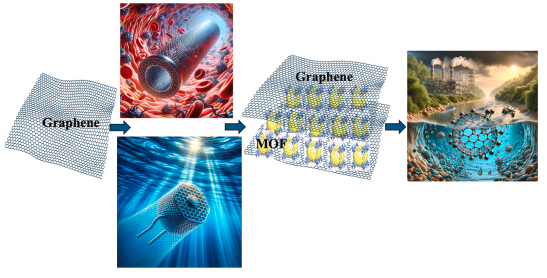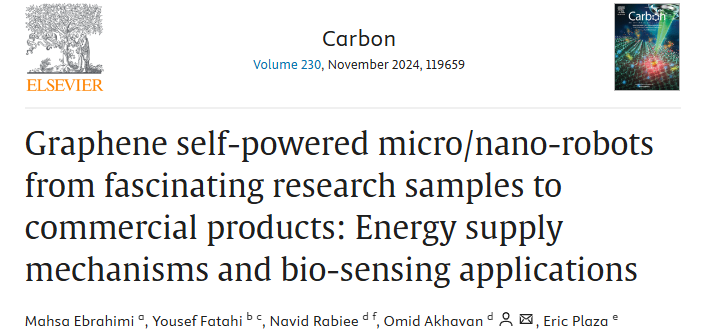Micro/Nanomotors: Revolutionary Advances in Medical and Environmental Applications

Micro/nanomotors have achieved significant advancements in medical and environmental applications. These tiny devices convert chemical energy into kinetic energy and can perform tasks in various ways, beneficial for a range of uses. New materials development is crucial for micro/nanomotor design, and graphene is one of the most promising candidates. With unique properties like high mobility, effective fluorescence quenching, large surface area, excellent coupling with advanced materials, high conductivity, and exceptional mechanical strength, graphene has made a substantial impact across multiple fields.
A review article titled “Graphene Self-Powered Micro/Nano-Robots: From Fascinating Research Samples to Commercial Products — Energy Supply Mechanisms and Bio-Sensing Applications” was published in Carbon by Omid Akhavan from Harvard University and Omid Akhavan from Sharif University of Technology, Iran. The article covers the features, fabrication methods, and propulsion mechanisms of graphene-based micro/nanomotors, highlighting the opportunities these low-cost, high-performance materials bring for future applications.
Summary
Over the past decade, a paradigm shift in nanotechnology has centered on carbon-based nanomaterials, which hold transformative potential across diverse fields. Graphene-based micro/nanomotors have recently emerged as one of the most promising tools for sensing, isolating, and degrading hazardous materials. These motors are a powerful example of carbon nanomaterials solving critical issues, with impressive advancements in environmental remediation, pollutant detection, accelerated purification processes, and medical diagnostics and treatment. They offer superior fluid transport, cost efficiency, reusability, high sensitivity, and rapid response, making them highly valuable in both environmental and biomedical fields.

Table 2. Summarized information regarding graphene-based micro/nano-motors.
| Type of motors | Synthesis approach | Mechanism | Potential applications | Ref |
| zirconia-graphene/Pt hybrid tubular micromotors | electrochemical template synthesis | bubble propulsion | capture and isolation of nerve agents | Singh et al. [47] |
| dye-labeled ssDNA/GO-coated Au tublar nanomotors | template electrosynthesis | ultrasound propelled | Efficient and quick detection of a specific miRNA molecule inside a cell | Ávila et al. [51] |
| GO-based micro/nano-bots | electrochemical deposition | bubble propulsion | The process of capturing, transferring, and removing a heavy metal such as Pb | Vilela et al. [126] |
| GO/Ti/Pt scrolls | a facile chemical method | bubble propulsion | in sensing, surface-enhanced Raman spectroscopy, and drug loading and delivery. | Yao et al. [66] |
| graphene-based micro/nano-motors with an alveolate surface of MnO2 | one-step hydrothermal method | hydrogen peroxide propelled | biomedical applications | Feng et al. [61] |
| graphene coated glass microswimmer | step by step chemical procedure | electric field, chemical potential gradient and external magnetic field propelled | diverse open and confined environments | Kumar et al. [111] |
| balloon-like MnOx–graphene crumples | an evaporation induced self-assembly and ultrasonic spray pyrolysis method | catalytic decomposition of H2O2 into O2 | sensors, drug-loading devices, monitors | Chen et al. [103] |
| nanometer thick graphene engine | Exfoliated ClF3 intercalated graphite | high power volume changeable actuator with LASER acts as the ignition plug | next generation devices | Lee et al. [113] |


